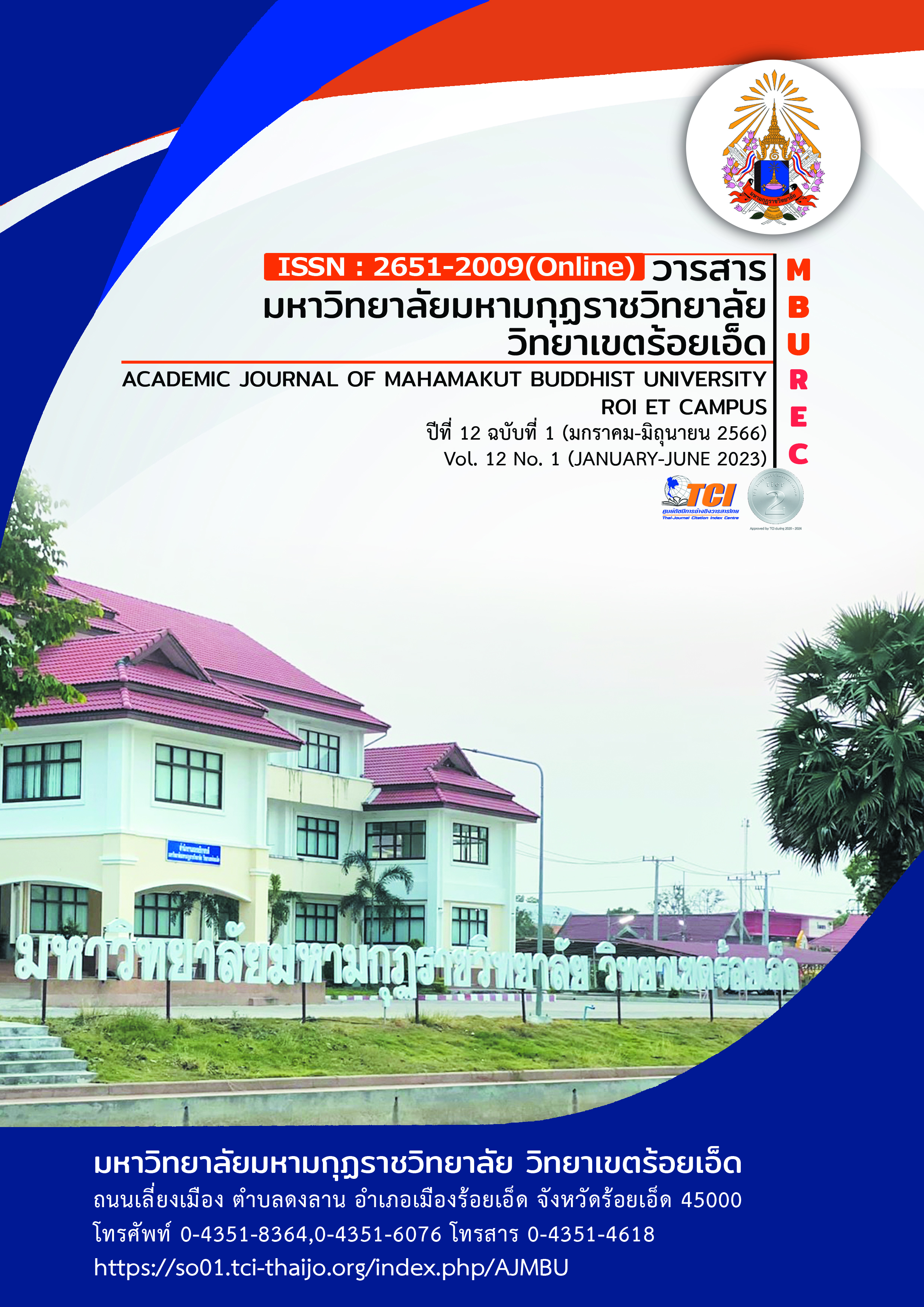กลยุทธ์การจัดการเรียนรู้วิถีชีวิตใหม่ สำหรับสถานศึกษา สังกัดสำนักงานเขตพื้นที่การศึกษาประถมศึกษามหาสารคาม เขต 2
Main Article Content
บทคัดย่อ
บทความวิจัยนี้มีวัตถุประสงค์ 1)เพื่อศึกษาสภาพปัจจุบัน สภาพที่พึงประสงค์ และความต้องการจำเป็นในการจัดการเรียนรู้วิถีชีวิตใหม่ สังกัดสำนักงานเขตพื้นที่การศึกษาประถมศึกษามหาสารคาม เขต 2 2)เพื่อพัฒนากลยุทธ์การจัดการเรียนรู้วิถีชีวิตใหม่สำหรับสถานศึกษา สังกัดสำนักงานเขตพื้นที่การศึกษาประถมศึกษามหาสารคาม เขต 2 กลุ่มตัวอย่างได้แก่ ครูผู้สอน สังกัดสำนักงานเขตพื้นที่การศึกษาประถมศึกษามหาสารคาม เขต 2 จำนวน 306 คน ผู้ทรงคุณวุฒิเกี่ยวกับกลยุทธ์การจัดการเรียนรู้วิถีชีวิตใหม่จำนวน 3 คน ผู้ทรงคุณวุฒิ ด้านการศึกษา จำนวน 7 คน เครื่องมือที่ใช้ในการวิจัย ได้แก่ แบบสอบถาม แบบประเมินความเหมาะสมและความเป็นไปได้ของกลยุทธ์ สถิติที่ใช้ในการวิเคราะห์ข้อมูล ได้แก่ ร้อยละ ค่าเฉลี่ย และส่วนเบี่ยงเบนมาตรฐาน
ผลการวิจัยพบว่า 1. สภาพปัจจุบันการจัดการเรียนรู้วิถีชีวิตใหม่ สำหรับสถานศึกษา สังกัดสำนักงานเขตพื้นที่การศึกษาประถมศึกษามหาสารคาม เขต 2 โดยรวมอยู่ในระดับมาก และสภาพที่พึงประสงค์การจัดการเรียนรู้วิถีชีวิตใหม่ สำหรับสถานศึกษา สังกัดสำนักงานเขตพื้นที่การศึกษาประถมศึกษามหาสารคาม เขต 2 โดยรวมอยู่ในระดับมาก 2. กลยุทธ์การจัดการเรียนรู้วิถีชีวิตใหม่สำหรับสถานศึกษา สังกัดสำนักงานเขตพื้นที่การศึกษาประถมศึกษามหาสารคาม เขต 2 ประกอบด้วย 10 กลยุทธ์หลัก 1)ปรับกระบวนทัศน์ด้านการใช้เทคโนโลยีในการจัดการเรียนรู้ของผู้สอน 2)ปรับกระบวนทัศน์ด้านการจัดการเรียนรู้ เพื่อให้ผู้เรียนมีคุณลักษณะตามการเรียนรู้วิถีชีวิตใหม่ 3)ปรับกระบวนการทัศน์ด้านรูปแบบการจัดการเรียนรู้ ให้สอดคล้องกับสภาพพื้นที่และความเสี่ยงในการติดเชื้อ 4)ใช้ชุมชนเป็นฐานการเรียนรู้ เพื่อส่งเสริมให้ผู้เรียนเกิดทักษะชีวิต ทักษะอาชีพ การนำไปปฏิบัติจริงในชีวิตประจำวัน 5)เสริมสร้างมาตรการทางสังคมเพื่อป้องกันการแพร่ระบาด เพื่อให้สถานศึกษาปลอดภัยตามมาตรการ Sandbox Safety Zone in School ของกระทรวงศึกษาธิการ 6)ปรับกระบวนทัศน์การนิเทศการจัดการเรียนรู้วิถีชีวิตใหม่ของสถานศึกษา เพื่อติดตามผลในการจัดการเรียนรู้ 7)ลดความความเหลื่อมล้ำเรื่องความพร้อม เครื่องมือสนับสนุนการเรียนของผู้เรียนในการเรียนรู้วิถีชีวิตใหม่ 8)สร้างความเข้าใจ ดูแล ช่วยเหลือ ให้กับผู้ปกครองเกี่ยวกับการจัดการเรียนรู้วิถีชีวิตใหม่ 9)ยกระดับการประเมินผลการเรียนรู้ในสอดคล้องกับการจัดการเรียนรู้วิถีชีวิตใหม่ 10)ส่งเสริมการใช้เทคโนโลยีในสถานศึกษา เพื่อช่วยให้ทันต่อการเปลี่ยนแปลง สอดคล้องกับการจัดการเรียนรู้วิถีชีวิตใหม่ผลการประเมินกลยุทธ์การจัดการเรียนรู้วิถีชีวิตใหม่สำหรับสถานศึกษา สังกัดสำนักงานเขตพื้นที่การศึกษาประถมศึกษามหาสารคาม เขต 2 โดยรวมมีความเหมาะสมและมีความเป็นไปได้อยู่ในระดับมากที่สุด
Article Details

อนุญาตภายใต้เงื่อนไข Creative Commons Attribution-NonCommercial-NoDerivatives 4.0 International License.
เอกสารอ้างอิง
กาญจนา บุญภักดิ์. (2563). การจัดการเรียนรู้ยุค New Normal. วารสารครุศาสตร์อุตสาหกรรม.19(2). A1-A6.
โกลบิช. (2563). โกลบิช เผย 4 รูปแบบการเรียนรับนิวนอร์มอลเพื่อการศึกษา. สืบค้นเมื่อ 1 เมษายน 2564. จาก https://www.matichon.co.th/lifestyle/tech/news2215023
ขัตติยา ด้วงสำราญ. (2552). รูปแบบการบริหารเชิงกลยุทธ์สำหรับโรงเรียนขนาดเล็ก. วิทยานิพนธ์ปริญญาปรัชญาดุษฎีบัณฑิต สาขาวิชาการบริหารการศึกษา. บัณฑิตวิทยาลัย : มหาวิทยาลัยศิลปกร.
ทิศนา แขมมณี. (2551). ศาสตร์การสอน:องค์ความรู้เพื่อการจัดกระบวนการเรียนรู้ที่มีประสิทธิภาพ. กรุงเทพมหานคร : สํานักพิมพ์จุฬาลงกรณ์มหาวิทยาลัย.
เทื้อน ทองแก้ว. (2563). การออกแบบการศึกษาในชีวิตวิถีใหม่: ผลกระทบจากการแพร่ระบาด COVID-19. คุรุสภาวิทยาจารย์ JOURNAL OF TEACHER PROFESSIONAL DEVELOPMENT. 1(2). 1-10.
บุญชม ศรีสะอาด. (2533). รูปแบบการควบคุมวิทยานิพนธ์. มหาสารคาม : โครงการสถาบันวิจัยและพัฒนาการเรียนการสอน มหาวิทยาลัยศรีนครินทรวิโรฒ มหาสารคาม.
พิเชษฐ ยังตรง. (2560). กลยุทธ์การพัฒนาคุณลักษณะที่พึงประสงค์ของผู้เรียนในสถานศึกษา ขั้นพื้นฐานในศตวรรษที่ 21. วิทยานิพนธ์ปริญญาปรัชญาดุษฎีบัณฑิต สาขาวิชาการจัดการศึกษา. มหาวิทยาลัยธุรกิจบัณฑิตย์.
ภูษิมา ภิญโญสินวัฒน์. (2563). จัดการเรียนการสอนอย่างไรในสถานการณ์โควิด-19: จากบทเรียนต่างประเทศสู่การจัดการเรียนรู้ของไทย. สืบค้นเมื่อ 30 เมษายน 2564. จาก https:// tdri.or.th/2020/05/examples-of-teaching-and-learning-in-covid-19-pandemic/
วิกิพีเดีย. (2565). การระบาดทั่วของไวรัสโคโรนา 2019. สืบค้นเมื่อ 21 กุมภาพันธ์ 2565. จาก https://en.wikipedia.org/wiki/Template:COVID-19pandemic_data
สำนักงานเขตพื้นที่การศึกษาประถมศึกษามหาสารคาม เขต 2. (2563). รายงานประจำปี. มหาสารคาม : กลุ่มงานและแผนสำนักงานเขตพื้นที่การศึกษาประถมศึกษามหาสารคาม เขต 2.
สำนักงานคณะกรรมการการศึกษาขั้นพื้นฐาน. (2563). การศึกษายุคดิจิทัล. สืบค้นเมื่อ 30 เมษายน2564. จาก https://www.posttoday.com/social/general/628541
สำนักงานคณะกรรมการการศึกษาขั้นพื้นฐาน. (2564). แนวทางการจัดการเรียนการสอนทางไกล ในสภานการณ์การแพร่ระบาดของ โรคติดเชื้อไวรัสโคโรนา 2019 (COVID-19) ระลอกใหม่. สืบค้นเมื่อ 20 พฤษภาคม 2564. จาก https://www.obec.go.th/archives/255396
สำนักงานเลขาธิการสภาการศึกษา. (2563). รายงานเรียนออนไลน์ยุคโควิด-19: วิกฤตหรือโอกาสการศึกษาไทย. กรุงเทพมหานคร : สำนักงานเลขาธิการสภาการศึกษา กระทรวงศึกษาธิการ.
สำนักงานสาธารณสุขจังหวัดมหาสารคาม. (2565). สถานการณ์ประจำวันนี้. สืบค้นเมื่อ 21 กุมภาพันธ์ 2565. จาก http://mkho.moph.go.th/mko/frontend/web/index.php/site/index
Good, C. (1967). The Human Organization : Its Management and Values. New York : McGraw- Hill Book Company.
Nadler . (1980). Corporate Human Resource Development. NewYork : Van.Nostrand Reinhold.
Pornphol and Chittayasothorn. (2020). System Dynamics Model of COVID-19 Pandemic Situation: The Case of Phuket Thailand. ICCMS '20: Proceedings of the 12th International Conference on Computer Modeling and Simulation. June 2020. 77-81.
THE STANDARD TEAM. (2020). อนาคตการศึกษาหลังโควิด-19 เป็นอย่างไร โรงเรียนยังจำเป็นอยู่ไหม. สืบค้นเมื่อ 24 พฤษภาคม 2564. จาก https://mb.com.ph/2020/08/09/ three-keys-to-education-in-the-new-normal/


